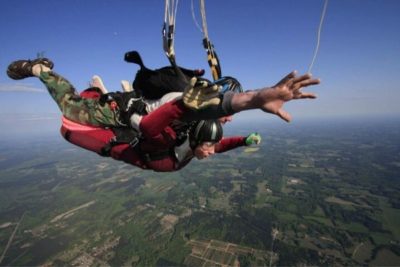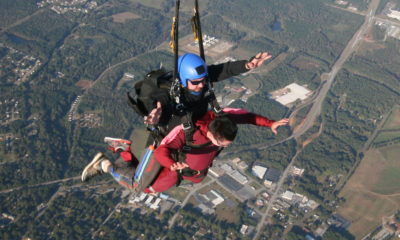In skydiving, heights are our friend! Skydiving altitudes set the stage for your entire jump experience. From the time spent on the plane to the amount of fun you get in freefall, altitude is often the primary determinant!
So, how high do skydivers jump from? It depends on several factors, including the jump plane and the skydiving discipline the jumpers on board are practicing. In most cases, the higher the skydiving altitude, the better! Let’s jump into all things altitude and learn why the sky’s the limit!
What is the Average Altitude for Skydiving?
 How high do skydivers fall from? Well, that’s entirely dependent on the airplane they are jumping from. The average skydive height at most skydiving centers is around 10,000 feet because most skydiving facilities utilize an aircraft called the Cessna 182. This plane is often considered the industry’s workhorse and has been hauling jumpers for a long time.
How high do skydivers fall from? Well, that’s entirely dependent on the airplane they are jumping from. The average skydive height at most skydiving centers is around 10,000 feet because most skydiving facilities utilize an aircraft called the Cessna 182. This plane is often considered the industry’s workhorse and has been hauling jumpers for a long time.
There are only two real cons associated with this aircraft. One is that the Cessna 182’s performance and efficiency max out above 10,000 feet. The second is that it can only hold 4 jumpers at a time (plus the pilot).
While 10,000 feet is nothing to scoff at, we’ve never met a skydiver who would say no to a little extra altitude. That’s where some of the bigger airplanes come in. Skydiving operations that can own or lease turbine aircraft often have an average skydiving altitude of 13,000 to 15,000 feet. They can also take up to 22 jumpers to altitude at once!
Skydiving Heights by Jump Type
As someone thinking about getting into skydiving, you might be wondering how high beginner skydivers jump. While most tandem skydives and student jumps fall into the average skydiving altitude category, there are many different disciplines experienced skydivers take part in that require lower or higher exits.
The minimum skydiving height that most licensed skydivers will jump from is between 3,000 and 4,000 feet. Skydives from this height are known as “hop’n pops” because the jumper essentially exits the door and immediately deploys their parachute. These jumps are often used for parachute flight training or high-performance landing competitions.
On the other end of the spectrum, skydivers will sometimes indulge in HALO skydives, meaning High Altitude Low Opening. Generally, these jumps take place from 17,000 to 18,000 feet, but can go much higher under special circumstances. Supplemental oxygen must be used for any jumps that occur at an altitude above 15,000 feet, and skydivers must undergo additional training.
Because altitude is such a commodity in skydiving, people often wonder just how high you can go. Can you skydive from 35,000 feet (i.e., from the altitude of a commercial plane)? How about 135,890 feet? That’s the current record for the highest skydive ever made, set by Alan Eustice in 2014. Skydivers love altitude because it gives them more time to play in the sky, but jumps that extreme require years of planning, specialized equipment, and nerves of steel!
How Altitude Affects Your Skydive
 Skydiving altitude directly affects the amount of freefall time you get to experience, which is sort of the main event. Freefall is where the rush happens! It’s the part of the jump that skydiving is famous for. The more time you have in freefall, the more you’ll get to experience the unique sensations of human flight. And the more memories you’ll catch on video!
Skydiving altitude directly affects the amount of freefall time you get to experience, which is sort of the main event. Freefall is where the rush happens! It’s the part of the jump that skydiving is famous for. The more time you have in freefall, the more you’ll get to experience the unique sensations of human flight. And the more memories you’ll catch on video!
So, how long does it take to fall 15,000 feet skydiving? From that height, which is the top end of average, you’ll experience about a full minute of freefall! That will be followed by five to eight minutes of parachute flight until you slide in for landing.
For comparison, jumps from 10,000 feet, or the low end of average, you’ll experience anywhere from 30 to 45 seconds of freefall. This amount of freefall time nearly doubles with a skydiving altitude of 15,000 feet.
From the skydiving altitude you generally get at Skydive Monroe, you will have a full, blissful minute of freefall!
Skydiving Heights at Skydive Monroe
Skydive Monroe is lucky enough to have the skydiving industry’s rocket ship: the King Air! This turbine aircraft seats up to 14 people and can take jumpers to a skydiving height of 14,000 feet in under 10 minutes. Not only does that come in at the high end of average skydiving altitudes, it’s also the fastest ride to altitude you can get! Higher jumps and faster rides mean max freefall time! Our fleet also includes a Cessna 182, which is used regularly for training and tandem jumps.
Ready to touch the sky? Skydive Monroe is eager to take you to new heights – book your skydive today! Blue skies.
Copyright © 2025, Skydive Monroe, All Rights Reserved.
DropZone Web Design & Marketing by Beyond Marketing, LLC



